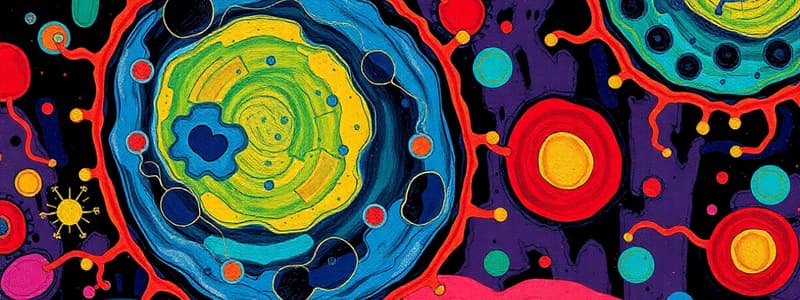Podcast
Questions and Answers
Which cell will be filled with molecules faster if the transport rate is the same?
Which cell will be filled with molecules faster if the transport rate is the same?
- Cell A will be faster due to larger volume
- Cell A will be faster due to larger surface area (correct)
- Both cells will fill at the same rate regardless of size
- Cell B will be faster due to larger volume
What two factors affect the efficiency of cell metabolism?
What two factors affect the efficiency of cell metabolism?
- Surface area and volume ratio (correct)
- Transport rate and cell age
- Cell shape and membrane thickness
- Nutrient availability and cell age
What structural adaptation allows cells to overcome limitations on size?
What structural adaptation allows cells to overcome limitations on size?
- Folding of the cell membrane (correct)
- Reduction in cell size
- Addition of more organelles
- Increased cell wall thickness
How does compartmentalization benefit eukaryotic cells?
How does compartmentalization benefit eukaryotic cells?
Why is maintaining a high surface area to volume ratio crucial for cells?
Why is maintaining a high surface area to volume ratio crucial for cells?
Which statement about transport proteins is correct?
Which statement about transport proteins is correct?
What role do carrier proteins play in facilitated diffusion?
What role do carrier proteins play in facilitated diffusion?
How do gated ion channels function?
How do gated ion channels function?
What happens to potassium ion channels in nerve cells during an electrical stimulus?
What happens to potassium ion channels in nerve cells during an electrical stimulus?
What is the primary factor that determines how easily a substance can pass through the plasma membrane?
What is the primary factor that determines how easily a substance can pass through the plasma membrane?
What defines diffusion in terms of particle movement?
What defines diffusion in terms of particle movement?
What is the significance of the selective permeability of membranes?
What is the significance of the selective permeability of membranes?
Which statement best describes a concentration gradient?
Which statement best describes a concentration gradient?
What type of molecules require transport proteins for membrane crossing?
What type of molecules require transport proteins for membrane crossing?
What role does the plasma membrane play in cellular function?
What role does the plasma membrane play in cellular function?
What condition is caused by a dysfunctional Cl- channel?
What condition is caused by a dysfunctional Cl- channel?
How do hydrophobic molecules interact with the phospholipid bilayer?
How do hydrophobic molecules interact with the phospholipid bilayer?
What is the primary function of channel proteins?
What is the primary function of channel proteins?
What happens at dynamic equilibrium during diffusion?
What happens at dynamic equilibrium during diffusion?
Which type of molecules have the most difficulty crossing the plasma membrane due to its hydrophobic interior?
Which type of molecules have the most difficulty crossing the plasma membrane due to its hydrophobic interior?
What occurs to a cell when placed in a hypertonic solution?
What occurs to a cell when placed in a hypertonic solution?
What role do cell-surface proteins play in relation to HIV?
What role do cell-surface proteins play in relation to HIV?
What is a consequence of lacking the CCR5 co-receptor?
What is a consequence of lacking the CCR5 co-receptor?
What is the primary function of tight junctions in epithelial tissues?
What is the primary function of tight junctions in epithelial tissues?
Which structure is responsible for cell-to-cell communication in animal cells?
Which structure is responsible for cell-to-cell communication in animal cells?
What type of junction anchors cells together in strong sheets?
What type of junction anchors cells together in strong sheets?
What is the main function of plasmodesmata in plant cells?
What is the main function of plasmodesmata in plant cells?
Which type of protein is responsible for attaching the cytoskeleton to the extracellular matrix (ECM)?
Which type of protein is responsible for attaching the cytoskeleton to the extracellular matrix (ECM)?
Which component is NOT part of the cytoskeleton structure?
Which component is NOT part of the cytoskeleton structure?
What role does cholesterol play in cell membranes at high temperatures?
What role does cholesterol play in cell membranes at high temperatures?
Which type of membrane protein spans the membrane and consists of hydrophobic regions?
Which type of membrane protein spans the membrane and consists of hydrophobic regions?
How do fibronectin and other extracellular matrix proteins interact with cellular components?
How do fibronectin and other extracellular matrix proteins interact with cellular components?
What is required for the activation of receptor tyrosine kinases (RTK)?
What is required for the activation of receptor tyrosine kinases (RTK)?
What is a key characteristic of integral proteins compared to peripheral proteins?
What is a key characteristic of integral proteins compared to peripheral proteins?
What initiates dimerization in receptor tyrosine kinases for signaling?
What initiates dimerization in receptor tyrosine kinases for signaling?
What effect does cholesterol have on membrane fluidity at low temperatures?
What effect does cholesterol have on membrane fluidity at low temperatures?
What function do membrane proteins primarily serve within the cell membrane?
What function do membrane proteins primarily serve within the cell membrane?
What is the primary function of glucose transporter 1 (GLUT 1) in red blood cells?
What is the primary function of glucose transporter 1 (GLUT 1) in red blood cells?
What type of proteins are involved in active transport processes?
What type of proteins are involved in active transport processes?
Which mechanism requires ATP to move substances against their concentration gradient?
Which mechanism requires ATP to move substances against their concentration gradient?
What is the result of the sodium-potassium pump's activity in cells?
What is the result of the sodium-potassium pump's activity in cells?
What does membrane potential refer to?
What does membrane potential refer to?
How does the inside of the cell typically compare to the outside regarding charge?
How does the inside of the cell typically compare to the outside regarding charge?
What ultimately drives the transport of glucose into red blood cells after it is phosphorylated?
What ultimately drives the transport of glucose into red blood cells after it is phosphorylated?
What is maintained by the active transport of ions in cells?
What is maintained by the active transport of ions in cells?
Flashcards
Cholesterol's Role in Membrane Fluidity
Cholesterol's Role in Membrane Fluidity
Cholesterol acts as a fluidity buffer in animal cell membranes, preventing excessive fluidity at high temperatures and excessive rigidity at low temperatures.
Peripheral Membrane Proteins
Peripheral Membrane Proteins
Peripheral proteins are associated with the surface of the cell membrane, loosely bound to the phospholipid bilayer or other membrane proteins.
Integral Membrane Proteins
Integral Membrane Proteins
Integral proteins penetrate the hydrophobic core of the cell membrane, spanning the entire bilayer.
Transmembrane Proteins
Transmembrane Proteins
Signup and view all the flashcards
Extracellular Matrix (ECM)
Extracellular Matrix (ECM)
Signup and view all the flashcards
Integrins
Integrins
Signup and view all the flashcards
Receptor Tyrosine Kinases (RTKs)
Receptor Tyrosine Kinases (RTKs)
Signup and view all the flashcards
RTK Activation and Deactivation
RTK Activation and Deactivation
Signup and view all the flashcards
Cell-Surface Proteins and HIV
Cell-Surface Proteins and HIV
Signup and view all the flashcards
What are cell junctions?
What are cell junctions?
Signup and view all the flashcards
Tight Junctions
Tight Junctions
Signup and view all the flashcards
Desmosomes (Anchoring Junctions)
Desmosomes (Anchoring Junctions)
Signup and view all the flashcards
Gap Junctions (Communicating Junctions)
Gap Junctions (Communicating Junctions)
Signup and view all the flashcards
Plasmodesmata in Plants
Plasmodesmata in Plants
Signup and view all the flashcards
Integrin Proteins
Integrin Proteins
Signup and view all the flashcards
What is the cytoskeleton?
What is the cytoskeleton?
Signup and view all the flashcards
Selective Permeability
Selective Permeability
Signup and view all the flashcards
Hydrophobic Molecules
Hydrophobic Molecules
Signup and view all the flashcards
Hydrophilic Molecules
Hydrophilic Molecules
Signup and view all the flashcards
Diffusion
Diffusion
Signup and view all the flashcards
Concentration Gradient
Concentration Gradient
Signup and view all the flashcards
Dynamic Equilibrium
Dynamic Equilibrium
Signup and view all the flashcards
Tonicity
Tonicity
Signup and view all the flashcards
Osmosis
Osmosis
Signup and view all the flashcards
Surface Area to Volume Ratio
Surface Area to Volume Ratio
Signup and view all the flashcards
Cell Size Limits
Cell Size Limits
Signup and view all the flashcards
Folding of Membranes
Folding of Membranes
Signup and view all the flashcards
Compartmentalization
Compartmentalization
Signup and view all the flashcards
Amoeba's Shape
Amoeba's Shape
Signup and view all the flashcards
Transport Proteins
Transport Proteins
Signup and view all the flashcards
Facilitated Diffusion
Facilitated Diffusion
Signup and view all the flashcards
Channel Proteins
Channel Proteins
Signup and view all the flashcards
Carrier Proteins
Carrier Proteins
Signup and view all the flashcards
Gated Channels
Gated Channels
Signup and view all the flashcards
Cystic Fibrosis
Cystic Fibrosis
Signup and view all the flashcards
Glucose transporter (GLUT 1)
Glucose transporter (GLUT 1)
Signup and view all the flashcards
Passive Transport
Passive Transport
Signup and view all the flashcards
Active Transport
Active Transport
Signup and view all the flashcards
Sodium-Potassium Pump
Sodium-Potassium Pump
Signup and view all the flashcards
Membrane Potential
Membrane Potential
Signup and view all the flashcards
Cytosol
Cytosol
Signup and view all the flashcards
ATP
ATP
Signup and view all the flashcards




